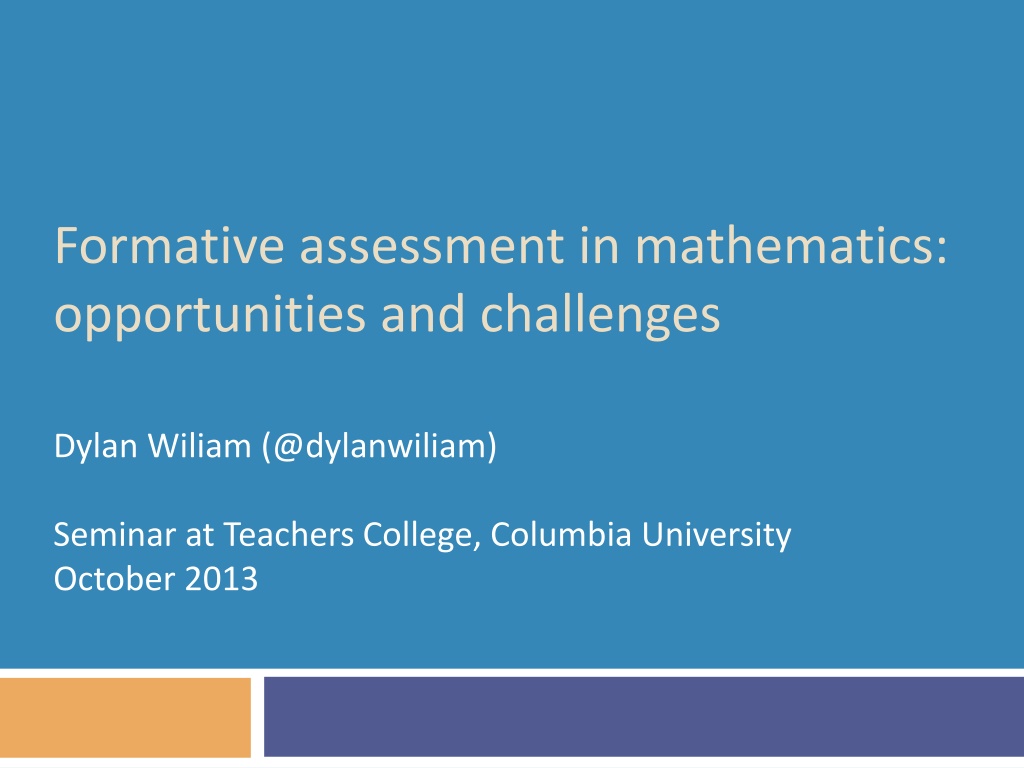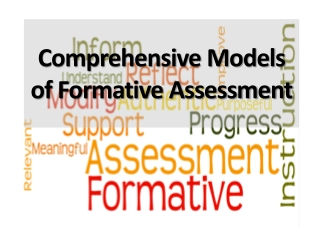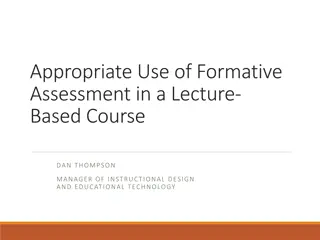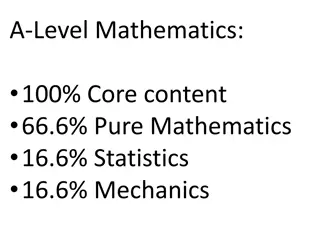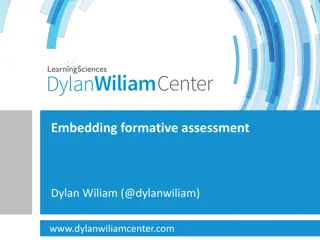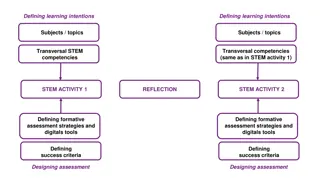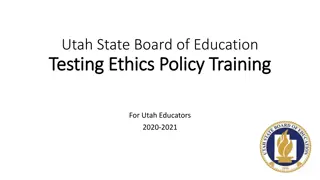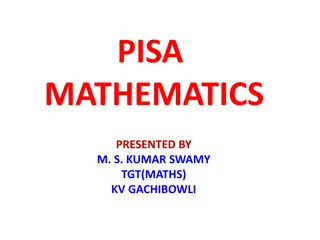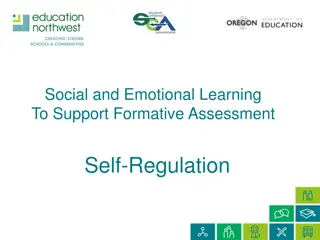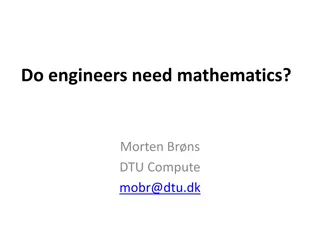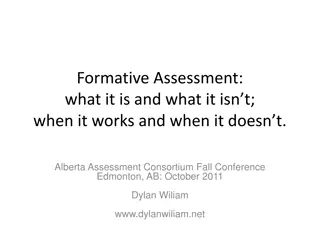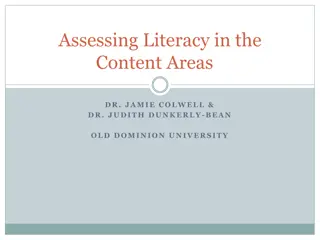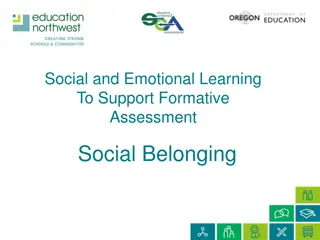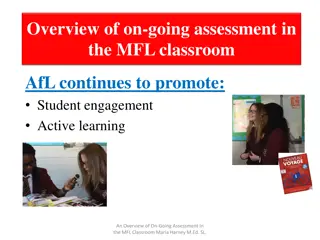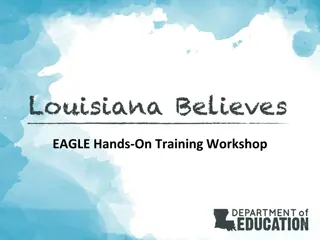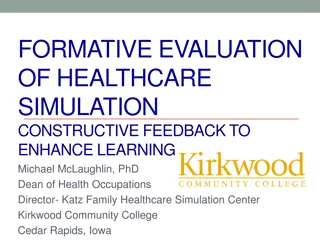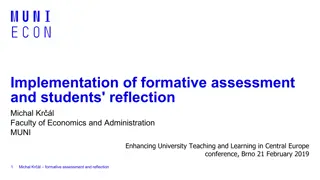Insights on Formative Assessment in Mathematics
Delve into the nuances of formative assessment in mathematics through a comprehensive exploration of definitional issues, the evidence base, and key definitions. Uncover the research agenda, challenges, and opportunities in implementing and adopting formative assessment practices to enhance student learning outcomes.
Uploaded on Oct 04, 2024 | 0 Views
Download Presentation

Please find below an Image/Link to download the presentation.
The content on the website is provided AS IS for your information and personal use only. It may not be sold, licensed, or shared on other websites without obtaining consent from the author.If you encounter any issues during the download, it is possible that the publisher has removed the file from their server.
You are allowed to download the files provided on this website for personal or commercial use, subject to the condition that they are used lawfully. All files are the property of their respective owners.
The content on the website is provided AS IS for your information and personal use only. It may not be sold, licensed, or shared on other websites without obtaining consent from the author.
E N D
Presentation Transcript
Formative assessment in mathematics: opportunities and challenges Dylan Wiliam (@dylanwiliam) Seminar at Teachers College, Columbia University October 2013
A research agenda for formative assessment Definitional issues Domain-specificity issues Effectiveness issues Communication issues Implementation issues Adoption issues ?
3 Definitional issues
The evidence base for formative assessment 4 Fuchs & Fuchs (1986) Natriello (1987) Crooks (1988) Bangert-Drowns, et al. (1991) Dempster (1991, 1992) Elshout-Mohr (1994) Kluger & DeNisi (1996) Black & Wiliam (1998) Nyquist (2003) Brookhart (2004) Allal & Lopez (2005) K ller (2005) Brookhart (2007) Wiliam (2007) Hattie & Timperley (2007) Shute (2008) ?
Definitions of formative assessment We use the general term assessment to refer to all those activities undertaken by teachers and by their students in assessing themselves that provide information to be used as feedback to modify teaching and learning activities. Such assessment becomes formative assessment when the evidence is actually used to adapt the teaching to meet student needs (Black & Wiliam, 1998 p. 140) the process used by teachers and students to recognise and respond to student learning in order to enhance that learning, during the learning (Cowie & Bell, 1999 p. 32) assessment carried out during the instructional process for the purpose of improving teaching or learning (Shepard et al., 2005 p. 275) ?
Formative assessment refers to frequent, interactive assessments of students progress and understanding to identify learning needs and adjust teaching appropriately (Looney, 2005, p. 21) A formative assessment is a tool that teachers use to measure student grasp of specific topics and skills they are teaching. It s a midstream tool to identify specific student misconceptions and mistakes while the material is being taught (Kahl, 2005 p. 11) ?
Assessment for Learning is the process of seeking and interpreting evidence for use by learners and their teachers to decide where the learners are in their learning, where they need to go and how best to get there (Assessment Reform Group, 2002 pp. 2-3) Assessment for learning is any assessment for which the first priority in its design and practice is to serve the purpose of promoting students learning. It thus differs from assessment designed primarily to serve the purposes of accountability, or of ranking, or of certifying competence. An assessment activity can help learning if it provides information that teachers and their students can use as feedback in assessing themselves and one another and in modifying the teaching and learning activities in which they are engaged. Such assessment becomes formative assessment when the evidence is actually used to adapt the teaching work to meet learning needs. (Black, Harrison, Lee, Marshall & Wiliam, 2004 p. 10) ?
Theoretical questions 8 Need for clear definitions So that research outcomes are commensurable Theorization and definition Possible variables Category (instruments, outcomes, functions) Beneficiaries (teachers, learners) Timescale (months, weeks, days, hours, minutes) Consequences (outcomes, instruction, decisions) Theory of action (what gets formed?) ?
Formative assessment: a new definition An assessment functions formatively to the extent that evidence about student achievement elicited by the assessment is interpreted and used, by teachers, learners, or their peers, to make decisions about the next steps in instruction that are likely to be better, or better founded, than the decisions that would have been taken in the absence of that evidence. ?
Unpacking formative assessment 10 Where the learner is going Where the learner is How to get there Providing feedback that moves learners forward Engineering effective discussions, tasks, and activities that elicit evidence of learning Teacher Clarifying, sharing and understanding learning intentions Peer Activating students as learning resources for one another Activating students as owners of their own learning Learner
Definitional issues: potential research How can formative assessment be defined and what are the consequences of different definitions, for psychometrics, for communication, and for adoption?
Pedagogy and didactics Some aspects of formative assessment are generic Some aspects of formative assessment are domain-specific There is a continuing debate about what aspects of formative assessment are generic (pedagogy) and which are domain-specific (didactics) ?
14 Clarifying, sharing and understanding learning intentions
A standard middle school math problem Two farmers have adjoining fields with a common boundary that is not straight. This is inconvenient for plowing. How can they divide the two fields so that the boundary is straight, but the two fields have the same area as they had before? ? ?
? ?
? ?
How many rectangles? ? m m-1 ( 2 ) ( ) n n-1 2 ?
Engineering effective discussions, activities, and classroom tasks that elicit evidence of learning
Questioning in math: Diagnosis 20 In which of these right-angled triangles is a2 + b2 = c2 ? b c A B a a c b a c C D b b c a a b E F c c b a ?
Diagnostic item: medians What is the median for the following data set? 38 74 22 44 96 22 19 53 a. 22 b. 38 and 44 c. 41 d. 46 e. 70 f. 77 g. This data set has no median ?
Diagnostic item: means What can you say about the means of the following two data sets? Set 1: Set 2: 10 10 12 12 13 13 15 15 0 A. The two sets have the same mean. B. The two sets have different means. C. It depends on whether you choose to count the zero. ?
Providing feedback that moves learners forward
Getting feedback right is hard Response type Feedback indicates performance falls short of goal exceeds goal Change behavior Increase effort Exert less effort Change goal Reduce aspiration Increase aspiration Abandon goal Decide goal is too hard Decide goal is too easy Reject feedback Feedback is ignored Feedback is ignored ?
Activating students: as learning resources for one another as owners of their own learning
+//interesting: responses for + 26 I got that ball-park estimates are supposed to be simple I know that you have to look at it and say OK I know that when I am adding the number I end up with must be bigger than the one I started at I get most of the problems It was easy for me because on the first one it says 328 so I took the 2 and made it a 12 I know that we would have to regroup I know how to do plus and minus because we have been doing it for a long time I get it when you cross out a number and make it a new one I know that when you can t from both colomes you go to the third colome and take that from it I know that when my answer is right the ball park estimate is close to it ?
+//interesting: responses for 27 I am still a tiny bit confused about subtraction regrouping I am a little bit confused about ball park estimates I get confused because sometimes I don t get the problem I am confused when you subtract really big numbers like 1,000 something I m still a little bit confused about regrouping Minus is confusing when you have to regroup twice Minus is a little bit hard when you have to regroup I don t understand when you borrow which colome you borrow from when both are 0 I am still confused about showing what I did to solve the problem I am a little confused about when you need to subtract ?
+//interesting: responses for interesting 28 Carrying the number over to the next number It s interesting how some people go to the nearest hundred while some go to the nearest ten It s interesting how some have to regroup twice It s pretty interesting about how you have to work really hard I am interested in borrowing because I didn t just get it yet. I want to really get to know it I find it weird that you could just keep going from colome to colome when you need to borrow On the ball park estimate it is easy but sometimes hard I really think that regrouping is pretty amazing It is cool how addition and subtraction regrouping is just moving numbers and you could get it right easily ?
Domain-specificity issues: potential research How much domain-specific knowledge does a teacher need in order to be able to implement high-quality formative assessment routines consistently? Can domain-specific formative assessment tools be independent of a particular curriculum? ?
Effects of formative assessment Standardized effect size: differences in means, measured in population standard deviations Source Effect size Kluger & DeNisi (1996) 0.41 Black &Wiliam (1998) Wiliam et al., (2004) 0.4 to 0.7 0.32 Hattie & Timperley (2007) 0.96 Shute (2008) 0.4 to 0.8 ?
32 Understanding meta-analysis: I think you ll find it s a bit more complicated than that (Goldacre, 2008)
Understanding meta-analysis 33 A technique for aggregating results from different studies by converting empirical results to a common measure (usually effect size) Standardized effect size is defined as: Problems with meta-analysis The file drawer problem Variation in population variability Selection of studies Sensitivity of outcome measures ?
34 The file drawer problem
The importance of statistical power The statistical power of an experiment is the probability that the experiment will yield an effect that is large enough to be statistically significant. In single-level designs, power depends on significance level set magnitude of effect size of experiment The power of most social studies experiments is low Psychology: 0.4 (Sedlmeier & Gigerenzer, 1989) Neuroscience: 0.2 (Burton et al., 2013) Education: 0.4 Only lucky experiments get published ?
Annual growth in achievement, by age 37 1.6 A 50% increase in the rate of learning for six- year-olds is equivalent to an effect size of 0.76 1.4 annual growth (SDs) 1.2 A 50% increase in the rate of learning for 15- year-olds is equivalent to an effect size of 0.1 1.0 0.8 0.6 0.4 0.2 0.0 5 6 7 8 9 10 11 12 13 14 15 16 Age Bloom, Hill, Black, and Lipsey (2008) ?
Variation in variability 38 Studies with younger children will produce larger effect size estimates Studies with restricted populations (e.g., children with special needs, gifted students) will produce larger effect size estimates ?
Feedback in STEM subjects 40 Review of 9000 papers on feedback in mathematics, science and technology Only 238 papers retained Background papers Descriptive papers Qualitative papers Quantitative papers Mathematics Science Technology 24 79 24 111 60 35 16 Ruiz-Primo and Li (2013) ?
Classification of feedback studies 41 1. Who provided the feedback (teacher, peer, self, or technology-based)? 2. How was the feedback delivered (individual, small group, or whole class)? 3. What was the role of the student in the feedback (provider or receiver)? 4. What was the focus of the feedback (e.g., product, process, self- regulation for cognitive feedback; or goal orientation, self-efficacy for affective feedback) 5. On what was the feedback based (student product or process)? 6. What type of feedback was provided (evaluative, descriptive, or holistic)? 7. How was feedback provided or presented (written, video, oral, or video)? 8. What was the referent of feedback (self, others, or mastery criteria)? 9. How, and how often was feedback given in the study (one time or multiple times; with or without pedagogical use)? ?
Main findings 42 Characteristic of studies included Maths Science Feedback treatment is a single event lasting minutes 85% 72% Reliability of outcome measures 39% 63% Validity of outcome measures 24% 3% Dealing only or mainly with declarative knowledge 12% 36% Schematic knowledge (e.g., knowing why) 9% 0% Multiple feedback events in a week 14% 17% ?
Sensitivity of outcome measures 44 Distance of assessment from the curriculum Immediate e.g., science journals, notebooks, and classroom tests Close e.g., where an immediate assessment asked about number of pendulum swings in 15 seconds, a close assessment asks about the time taken for 10 swings Proximal e.g., if an immediate assessment asked students to construct boats out of paper cups, the proximal assessment would ask for an explanation of what makes bottles float Distal e.g., where the assessment task is sampled from a different domain and where the problem, procedures, materials and measurement methods differed from those used in the original activities Remote standardized national achievement tests. Ruiz-Primo, Shavelson, Hamilton, and Klein (2002) ?
Impact of sensitivity to instruction 45 Effect size Close Proximal ?
Effectiveness issues: potential research Under what kind of conditions does the implementation of formative assessment practices in classrooms lead to student improvement? What kinds of increases in the rate of student learning are possible?
Dissemination models Gas-pump attendant FedEx IKEA Sherpa Gardener PhD supervisor ?
So much for the easy bit Ideas Theorization Products Evidence of impact Advocacy ?
Communication issues: potential research How can the vision of effective formative assessment practice be communicated to teachers? ?
